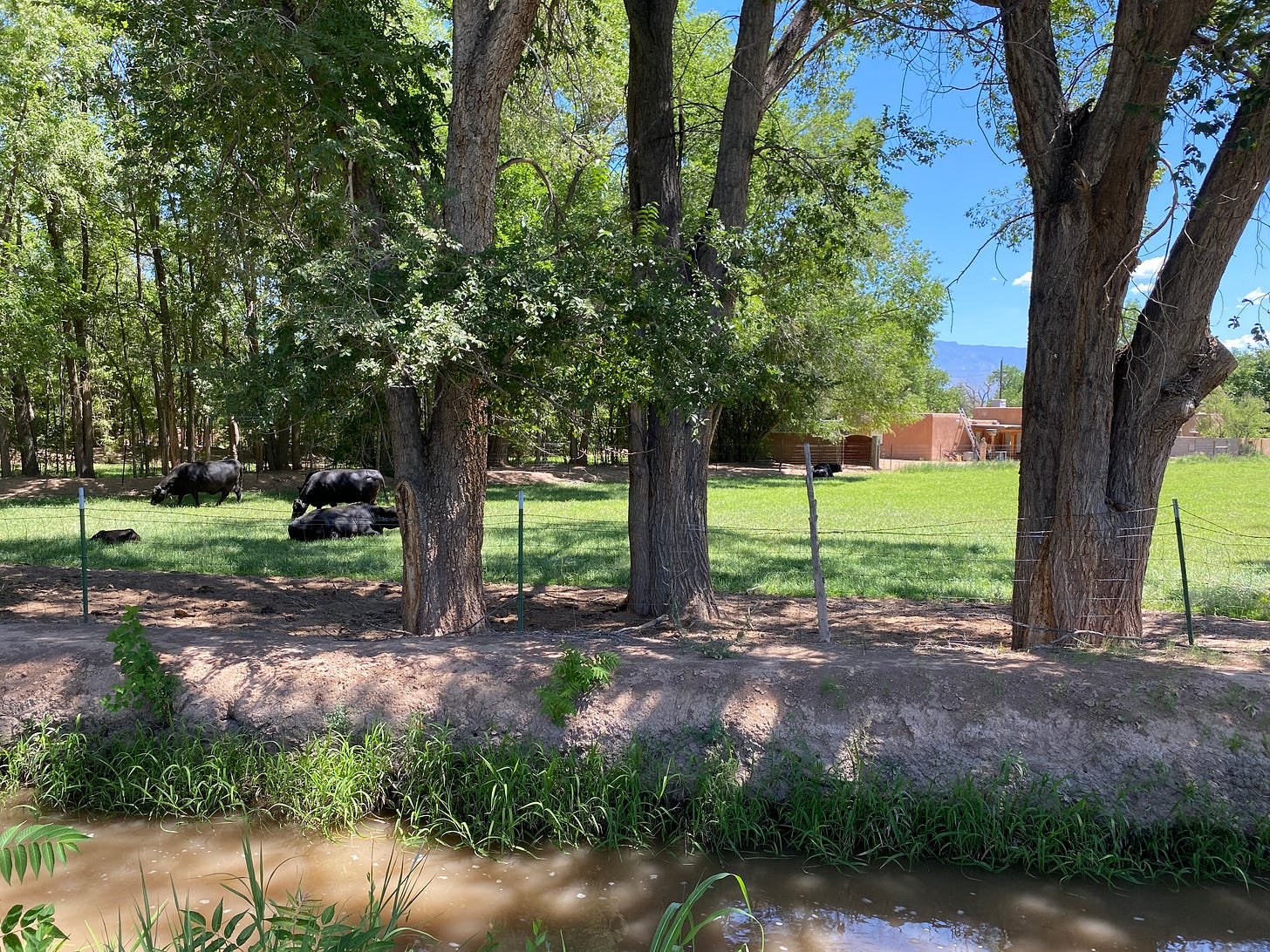Rethinking acequias as climate solutions in car-centric Albuquerque
Shade, greenery, and fun should highlight our decarbonization efforts
Traveling by bicycle is not easy to do in most parts of the United States. Sprawling urban areas and car dependent infrastructure make cities more dangerous and difficult to navigate by bike. Albuquerque, NM is also sprawling and dangerous to navigate by bike, but historic irrigation ditches called acequias offer cyclists safe and enjoyable routes that pander to biodiversity, not cars. As we look to decarbonize our transportation sector, lets remember that fun alternatives to driving can be more equitable and effective than EV mandates.
These ancient water-ways have a long history in central and northern New Mexico and still have farming and cultural relevance to New Mexicans today. Acequias are the oldest man-made waterways in the United States and just happen to offer cyclists and pedestrians beautiful, safe, and shaded bicycle routes throughout the city.
I recently went for a bike ride during the hottest part of the day, but the trails and acequias around the Rio Grande kept me shaded and cool - unlike the many unshaded bike lanes in Albuquerque.
My route started on the paved and dirt trails along the Rio Grande where there are options for road, gravel, and mountain bikes to navigate up and down Albuquerque’s spacious Rio Grande Bosque. I hopped between the dirt and paved paths without worry as there are no cars allowed in the bosque area - unlike the inhospitable roads that connect our homes, grocery stores, and work.
After riding north along the Rio Grande, I turned along the Griegos Lateral, an acequia near Montano Road where I snapped the pictures below:
The acequia offered a winding, sometimes bumpy, ride with shade, running water, and beautiful scenes of small farms, mountain views, and an abundance of life. I was both appalled by beauty and having so much fun I didn’t realize just how far I had gone - Acequias are a reminder that riding a bike in the city can be enjoyable.
Riding a bike in Albuquerque is often associated with heat, impatient drivers, and a high risk of getting hit by a car. While Albuquerque has a few good bicycle-only routes and they’re adding more all the time, it’s also the most dangerous city in the US to be a pedestrian. New Mexico’s humble acequia is the canary in the coal mine that could help inspire a more robust cycling culture in America.
Cycling in America is viewed as a hobby rather than a legitimate mode of transportation. Despite being a healthier, more efficient, and space saving alternative to driving, cycling for transportation has not taken off in the US, let alone Albuquerque, but making cycling enjoyable again could help bring the mode of transportation back from the fringes.
Unfortunately, it looks like many Americans have never ridden their bike on an acequia, because bicycles don’t seem to be on anyones climate agenda in the US. Electric vehicles have taken the spotlight in America as policies like ACC2 further cement Americas addiction to inefficient, individualized transportation.
ACC2 and full-decarbonization
As our fight against climate catastrophe unfolds, the transportation sector will have to undergo massive change. America is going all in on heavy, mineral intensive, expensive, electric vehicles (EV) as states like New Mexico look to adopt Advanced Clean Cars 2 (ACC2) - a Section 177 State rule that would mandate much higher EV sales in the state.
I have a lot to say about ACC2, so I will do a more detailed analysis of the rule soon, but what I will say about the rule now is that for all the bad things that come with embracing EVs, it’s a necessary rule. The increased mining, accentuated car-dependency, and lack of charging stations in the wild are issues that come with embracing EVs, but these challenges are still outweighed by the urgency to decarbonize. Therefor, ACC2 is a good thing overall, and EVs will help in the climate fight, but it’s not the solution to all of our climate problems.
We still need better public transit, pedestrian infrastructure, and strategic density in order to equitably decarbonize transportation. Electric vehicles are more expensive than their gas-powered counterparts, making ACC2 a regressive policy that makes transportation more expensive for New Mexicans. In order to combat that regressiveness, the Governor probably shouldn’t have vetoed the EV tax credit bill in the 2023 legislative session.
Anyways, like I said, more on ACC2 some other time.
Sometimes, the best solutions are the simplest
We can dramatically reduce the amount of lithium and parking lots needed to decarbonize our transportation sector if we look to simpler solutions like bicycles and acequias. Climate solutions aren’t only about embracing new technologies, but remembering old ones.
Acequias make as much economic sense today as they did 500 years ago because they are simple and efficient. They provide water to farmers via the power of canals and gravity. Not only are they sustainable, but they provide a safe route for biodiversity to thrive and people to get around. Why can’t we take this idea and use it to increase bike usage, greenery, and biodiversity in cities? What if riding your bike to work was as enjoyable as my joy ride the other day?
Albuquerque’s acequias and larger irrigation network already host some bike paths, like on the Paseo del Nordeste Trail, but the full potential of what this water/bike network can be is still untapped:

Getting around American cities by bike is uncomfortable, so people don’t ride their bikes. They’d rather ride in a climate-controlled car than pedal on the shoulder of a hot, busy highway, which is totally fair. It’s time to reimagine what our cities could feel like by drawing inspiration from simple solutions of the past.
It will be a massive achievement if society can eventually decarbonize, but let’s also remember that how we decarbonize will be just as important.






